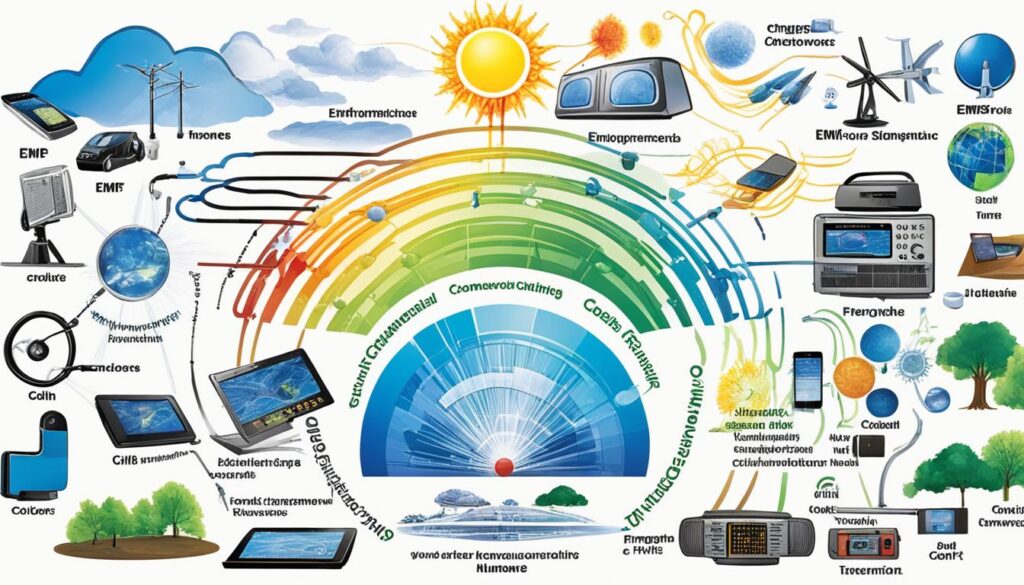Disclosure: This Post Contains Affiliate Links; We earn a commission on purchases.
Welcome to our article on the ICNIRP Guidelines for EMF Protection. In today’s digital era, where electromagnetic fields (EMFs) surround us, it is essential to understand the science behind EMF protection and radiation safety standards. The International Commission on Non-Ionizing Radiation Protection (ICNIRP) has developed guidelines that provide a framework for safeguarding individuals exposed to radiofrequency electromagnetic fields.
These guidelines encompass a wide range of applications, including 5G technologies, WiFi, Bluetooth, mobile phones, and base stations. They build upon previous versions from 1998 and 2010, incorporating the latest advancements in scientific knowledge and technology development. By adhering to these guidelines, individuals can ensure their safety while benefiting from the convenience and connectivity these technologies offer.
Key Takeaways:
- ICNIRP Guidelines provide protection for humans exposed to radiofrequency electromagnetic fields (RF) in the range of 100 kHz to 300 GHz.
- The guidelines cover various applications such as 5G technologies, WiFi, Bluetooth, mobile phones, and base stations.
- They are an update to previous guidelines from 1998 and 2010, incorporating advancements in scientific understanding.
- The ICNIRP Guidelines aim to establish exposure limits that ensure a high level of protection against substantiated health effects.
- Compliance with the guidelines helps individuals minimize their risk and ensure the safe use of technologies utilizing EMFs.
Scope and Purpose of the Guidelines
The ICNIRP Guidelines are designed to provide clear and comprehensive guidelines on electromagnetic field exposure limits, ensuring the protection of individuals from the potential adverse effects of radiofrequency electromagnetic fields (RF-EMFs). These guidelines specifically focus on the frequency range of 100 kHz to 300 GHz, which encompasses a wide range of technologies such as 5G, WiFi, and mobile phones.
The primary purpose of the ICNIRP Guidelines is to establish exposure limits that offer a high level of protection against substantiated health effects caused by both short-term and long-term RF-EMF exposure. By adhering to these guidelines, individuals can minimize the risks associated with electromagnetic field exposure and ensure their safety in various environments.
It’s important to note that the ICNIRP Guidelines have limitations and may not cover all scenarios. Certain situations, such as medical procedures or participation in research studies, may require additional considerations beyond the scope of these guidelines. Nevertheless, the ICNIRP Guidelines provide invaluable guidance for protecting individuals from potential harmful effects caused by electromagnetic fields in everyday settings.
Key Principles for Limiting Exposure to Radiofrequency EMFs
The ICNIRP Guidelines provide essential principles for protecting individuals from radiofrequency electromagnetic fields (RF EMFs). These guidelines establish quantitative levels for personal exposure to RF EMFs in order to safeguard against any potential harmful effects. By setting thresholds for adverse health effects and incorporating reduction factors to address biological variability and uncertainty, the guidelines ensure a high level of protection.
The ICNIRP Guidelines emphasize the importance of considering various factors, such as age, sex, and environmental conditions, when defining basic restrictions and reference levels. These factors play a significant role in determining compliance with the exposure limits. With this holistic approach, the guidelines seek to address the unique vulnerabilities and susceptibilities of different individuals.
The primary objective of the ICNIRP Guidelines is to minimize the risks associated with RF EMF exposure. By following these guidelines, individuals can effectively limit their exposure to radiofrequency radiation, protecting themselves from any potential adverse health effects.
Electric Field Protection and Magnetic Field Exposure Limits
Understanding electric field protection and magnetic field exposure limits is essential in minimizing the potential risks associated with RF EMFs. Electric fields, which are present in everyday environments due to electrical devices and power lines, can have biological effects on human health. ICNIRP Guidelines define exposure limits for electric fields to ensure safe levels of exposure.
Magnetic fields, on the other hand, are generated by power lines, electrical devices, and magnetic resonance imaging (MRI) machines, among others. Prolonged exposure to magnetic fields can lead to adverse health effects. The ICNIRP Guidelines establish exposure limits for magnetic fields to protect individuals from potential harm.
By adhering to these defined electric field protection and magnetic field exposure limits, individuals can mitigate the risks associated with RF EMF exposure and maintain a safe and healthy environment.

Practical Implementation of the Guidelines
The ICNIRP Guidelines serve as a crucial reference for regulatory bodies, policymakers, and industry professionals when designing and implementing RF EMF protection measures. These guidelines play a vital role in ensuring that individuals are adequately protected while using various technologies.
Furthermore, the ICNIRP Guidelines offer guidance for conducting risk assessments and evaluating compliance with exposure limits. This enables stakeholders to assess the potential risks associated with RF EMF exposure and take appropriate measures to address them.
By embracing the key principles outlined in the ICNIRP Guidelines and implementing them effectively, individuals, organizations, and societies can create a safer and healthier environment in the face of advancing technologies and increasing RF EMF exposure.
Updates and Revisions of the Guidelines
The current ICNIRP Guidelines represent a significant update from their predecessors, the ICNIRP (1998) guidelines and ICNIRP (2010) low-frequency guidelines. These revisions take into account the latest advancements in scientific understanding, technological developments, and new research on the health effects of RF exposure. By incorporating these updates, the guidelines provide the most up-to-date recommendations for protecting individuals against the potential adverse health effects associated with exposure to electromagnetic fields.
The ICNIRP (1998) guidelines served as foundational principles for limiting exposure to radiofrequency electromagnetic fields in the 100 kHz to 300 GHz frequency range. However, the rapidly evolving landscape of technology and an increasing body of research necessitated a comprehensive revision to ensure the guidelines remain relevant and effective in safeguarding human health.
“Our understanding of the potential health effects of RF exposure has significantly evolved since the publication of the ICNIRP (1998) guidelines. The scientific community has made substantial progress in studying the biological effects of RF radiation, and it is essential that our guidelines reflect these advancements to provide the highest level of protection.”
– Dr. Eric van Rongen, Chairman of ICNIRP
The revised guidelines consider the latest scientific literature, encompassing a wide range of studies and research on the biological effects of RF exposure. They establish quantitative levels for personal exposure to radiofrequency EMFs based on factual evidence, ensuring that the recommendations are grounded in robust scientific principles and expertise.
Notably, the ICNIRP (2010) low-frequency guidelines were also replaced, reflecting the need for updated standards in that specific frequency range. This comprehensive revision ensures that the guidelines maintain the highest standards of electromagnetic field protection across the entire spectrum, providing a unified and consistent approach to safeguarding human health.
| ICNIRP Guidelines | Publication Year |
|---|---|
| ICNIRP (1998) guidelines | 1998 |
| ICNIRP (2010) low-frequency guidelines | 2010 |
| Current ICNIRP Guidelines | 2021 |
By staying up-to-date with the latest scientific findings and technological advancements, ICNIRP ensures that its guidelines continue to provide the highest level of protection against the potential health effects of RF exposure. These updated guidelines offer a solid foundation for regulatory frameworks and industry standards worldwide, enabling the safe and responsible use of technologies utilizing radiofrequency electromagnetic fields.
Public Consultation and Translation
As part of its commitment to transparency and inclusivity, ICNIRP conducts public consultations for the draft guidelines. This provides an opportunity for anyone, be it individuals, experts, or organizations, to contribute their insights, feedback, and concerns regarding the proposed guidelines. ICNIRP values the input received during these consultations, as it helps ensure that the guidelines accurately reflect the needs and concerns of all stakeholders.
In addition to public consultations, ICNIRP recognizes the importance of making the guidelines accessible to a global audience. To achieve this, ICNIRP provides translations of the guidelines and related documents in multiple languages. This allows individuals from different regions and linguistic backgrounds to comprehend and engage with the guidelines effectively.
The translations are available in languages such as Italian, Japanese, Portuguese, and more. However, it is important to note that the English version serves as both the source language and the official reference for all translations. This ensures consistency and accuracy across different language versions, avoiding any potential misinterpretations or discrepancies.
Public Consultation Process
The public consultation process conducted by ICNIRP involves the following steps:
- Publication of the draft guidelines and related documents on the ICNIRP website, accompanied by a call for public input.
- A specified period (usually several weeks) for interested individuals and organizations to review the draft guidelines and submit their comments.
- Thorough consideration and analysis of all received comments and feedback.
- Revision of the draft guidelines based on the insights and suggestions received.
- Publication of the final version of the guidelines, incorporating the relevant revisions and updates.
This comprehensive process ensures that ICNIRP takes into account a wide range of perspectives and expert opinions, resulting in guidelines that are evidence-based, balanced, and reflect the current understanding of the potential health effects of electromagnetic fields.
Translation Process
ICNIRP recognizes the importance of providing translations of the guidelines to facilitate global understanding and engagement. The translation process follows a meticulous approach to maintain the accuracy and clarity of the content:
- Selection of qualified and experienced translators with expertise in both the subject matter and the target language.
- Translation of the guidelines and related documents while ensuring accurate conveyance of the original meaning and intent.
- Proofreading and editing of the translated texts to ensure linguistic quality and consistency.
- Review by subject matter experts to ensure the translated versions accurately reflect the original guidelines.
- Publication of the translated guidelines on the ICNIRP website and their availability for download.
ICNIRP’s commitment to providing translations enhances the accessibility of the guidelines and promotes global collaboration towards electromagnetic field protection.
Additional Information and Resources
Along with the ICNIRP Guidelines, the International Commission on Non-Ionizing Radiation Protection provides additional resources to address common questions and concerns. These resources aim to provide clarity and further information on specific topics related to electromagnetic field (EMF) protection and the guidelines themselves.
Frequently Asked Questions (FAQs)
ICNIRP has compiled a comprehensive list of frequently asked questions (FAQs) to address common queries about EMF exposure and the guidelines. These FAQs cover a wide range of topics, including the health effects of RF exposure, the implementation of exposure limits, and the safety of 5G technologies. By referring to the FAQs, individuals can find answers to their specific concerns and gain a better understanding of EMF protection.
Differences between 2020 and 1998 Guidelines
The ICNIRP guidelines have evolved over the years to incorporate new scientific research and advancements in technology. It is crucial to understand the key differences between the 2020 guidelines and the previous 1998 guidelines. ICNIRP provides detailed information highlighting any significant changes, allowing individuals to stay up to date with the latest recommendations for protecting against adverse health effects.
5G Information
With the widespread implementation of 5G technologies, ICNIRP recognizes the specific questions and concerns surrounding these advancements. To address these issues, ICNIRP offers information specifically related to 5G technologies’ safety and EMF exposure. This information aims to provide individuals with the necessary knowledge to make informed decisions and alleviate any uncertainties surrounding 5G’s impact on health.
By utilizing these additional resources, individuals can access further information, clarifications, and answers to their specific questions, ensuring a comprehensive understanding of EMF protection and the ICNIRP Guidelines.

Conclusion
The ICNIRP Guidelines for EMF Protection provide a comprehensive framework for limiting exposure to electromagnetic fields in the frequency range of 100 kHz to 300 GHz. These guidelines are the result of extensive research and scientific understanding of the potential health effects of RF exposure. By following these guidelines, individuals can minimize their risk and ensure the safe use of technologies that utilize radiofrequency electromagnetic fields.
The ICNIRP Guidelines are designed to establish exposure limits that protect against substantiated adverse health effects from both short- and long-term exposure to radiofrequency EMFs. They provide a high level of protection for all individuals, taking into account factors such as age, sex, and environmental conditions.
With the rapid advancement of technology and the increasing use of wireless devices, the ICNIRP Guidelines play a crucial role in setting radiation safety standards. By adhering to these guidelines, we can take important steps toward EMF protection and prioritize our well-being in an increasingly connected world.
Source Links
- https://www.icnirp.org/en/activities/news/news-article/rf-guidelines-2020-published.html
- https://www.icnirp.org/en/publications/article/rf-guidelines-2020.html
- https://www.icnirp.org/cms/upload/publications/ICNIRPrfgdl2020.pdf

Subscribe to Our Newsletter










